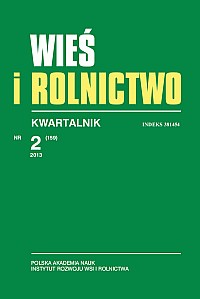The role of small farms in Italy: between subsistence and diversification
DOI:
https://doi.org/10.53098/wir.2013.2.159/05Keywords:
small farms, FADN, multifunctionality, income diversification, CAPAbstract
The paper explores the role of small farms in Italy, by analyzing the significance of on-farm farming and non-farming activities on the basis of the Italian FADN database (Farm Accounting Data Network), covering the period from 2003 to 2009. Small farms were classified into six mutually exclusive and homogeneous groups (two groups of micro-farms and four groups of small farms) according to their degree of diversification and differentiation of production and, for each group, the economic sustainability as well as the role of public support were assessed through a set of indicators. The results of the analysis confirm the non-economic role of micro-farms, whose justification needs to be rather found in territorial and social objectives. With regard to the small farms, the results show that, even though conventional profiles are still predominant, a significant number of small farms shows some sort of interest towards diversification and multifunctionality. The majority of farms in the panel focused on the strategy of differentiation through quality products, which is a key aspect for Italian agriculture performance and competitiveness. Finally, the indicators on public support seem to confirm the complementary role of rural development policies to the first pillar of the CAP, by highlighting the need of implementing more effective policy tools aimed at preventing the exit of small farms from the sector, also by supporting the entrepreneurial skills necessary to react and reverse the marginalization process.References
Ascione E., Carillo F., Vagnozzi A., 2011: Verso la consulenza alla gestione attraverso la RICA. Creazione di gruppi omogenei di imprese e verifica dei risultati economici. Working Paper, Rete Rurale Nazionale, giugno 2011.
Borsotto P., Henke R., 2007: Agricoltura mediterranea e multifunzionalità: il caso italiano. ”Politica Agricola Internazionale” 2: 29–47.
Cagliero R., Novelli S., 2012: Giovani e senilizzazione nel Censimento dell’agricoltura. ”AgriRegioniEuropa” 8: 11–15.
Davidova S., Fredriksson L., Bailey A., 2009: Subsistence and semi-subsistence farming in selected EU new Member States. 111th EAAE Seminar “Small farms: decline or persistence?” University of Kent, 26–27 June, Canterbury, UK.
De Benedictis M., 2002: L’agricoltura del Mezzogiorno: ‘la polpa e l’osso’ cinquant’anni dopo. ”QA – La Questione Agraria” 2: 199–236.
De Benedictis M., 2005: L’agricoltura del Mezzogiorno ieri e oggi: fattori di crisi e di rilancio. ”Rassegna Economica” 2: 13–43.
De Benedictis M. (ed.), 1995: Agricultura familiare in transizione. INEA Studi & Ricerche, Roma.
De Filippis F., 1985: Il part-time nel dibattito sulla stratificazione aziendale dell’agricoltura italiana. „La Questione Agraria” 18: 3–25.
De Filippis F. (ed.), 2012: La nuova PAC 2014-2020. Un’analisi delle proposte della Commissione. Quaderni del Gruppo 2013, Tellus, Roma.
De Filippis F., Romano D. (ed.), 2010: Crisi economica e agricoltura. Quaderni del Gruppo 2013, Tellus, Roma.
Fabiani G., 1995: L’agricoltura italiana nello sviluppo dell’Europa comunitaria. In: Storia dell’Italia repubblicana. Vol. II. Politica, economia, società, Einaudi, Torino.
Henke R. (ed.), 2004: Verso il riconoscimento di un’agricoltura multifunzionale. Teorie, politiche, strumenti. Edizioni Scientifiche Italiane, Napoli.
Henke R., Salvioni C., 2008: Multifunzionalità in agricoltura: sviluppi teorici ed evidenze empiriche. “Rivista di Economia Agraria” 1.
Henke R., Salvioni C., 2011: La diversificazione dei redditi nelle aziende agricole italiane. ”QA – Rivista dell’Associazione Rossi-Doria” 3: 25–56. DOI: https://doi.org/10.3280/QU2011-003002
Lipton M., 2005: The family farm in a globalizing world: the role of crop science in alleviating poverty. Discussion paper No. 40. International Food Policy Research Institute, Washington D.C.
Mahé L.P., 2012: Do the proposals for the CAP after 2013 herald a ‘major’ reform? Policy Paper No 53, Notre Europe, Paris.
Mardsen T., Sonnino R., 2008: Rural development and the regional state: denying multifunctional agriculture in the UK. “Journal of Rural Studies” 24: 422–431. DOI: https://doi.org/10.1016/j.jrurstud.2008.04.001
Matthews A. (ed.), 2012: The common agricultural policy after 2013. “Intereconomics” 6: 316–342. DOI: https://doi.org/10.1007/s10272-012-0435-6
OECD, 2009: The role of agriculture and farm household diversification in the rural economy. Paris.
Russo C., Sabbatini M., 2005: Analisi esplorativa delle differenziazioni strategiche delle aziende agricole. ”Rivista di Economia Agraria” 4: 659–695.
Saraceno E., 1985: Il part-time nell’agricoltura dei Paesi occidentali: linee evolutive e strumenti di intervento. ”La Questione Agraria” 18: 47–64.
Saraceno E., 1994: The modern functions of small farm systems: an Italian experience. “Sociologia Ruralis” XXXIV, 4: 308–328. DOI: https://doi.org/10.1111/j.1467-9523.1994.tb00815.x
Sotte F., 2006: Quante sono le imprese agricole in Italia? “AgriRegioniEuropa” 5: 12–16.
Wilson G.A., 2007: Multifunctional agriculture. A transition theory perspective. CABI Publishing, Wallingford (UK) and Cambridge (MA, USA). DOI: https://doi.org/10.1079/9781845932565.0000
Wilson G.A., 2008: From ‘weak’ to ‘strong’ multifunctionality: conceptualising farm-level multifunctional transitional pathways. “Journal of Rural Studies” 24: 367–383. DOI: https://doi.org/10.1016/j.jrurstud.2007.12.010
Downloads
Article file downloads
Pages
How to Cite
Issue
Section
License
Copyright (c) 2013 Wieś i Rolnictwo

This work is licensed under a Creative Commons Attribution 4.0 International License.










